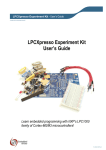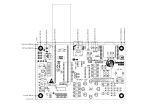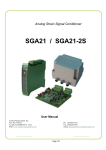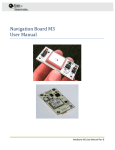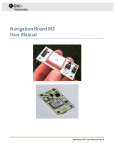Download Real Time System Term Project Pre
Transcript
Real Time System Term Project Pre-Programmed Course Navigator Marty Peltz Using the LCPXpresso 1343 microcontroller ECE 3510 Due: 12/12/2011 Abstract The Real Time system being produced for my project is a pre-programmed vehicle that is designed to run a laid out course. The Vehicle itself is driven by two separate motors controlling the two front wheels. These wheels are powered by a battery and regulated by the LPCXpresso board. The LPCXpresso board controls a relay for each motor so the motor can be switched on and off. The vehicle turns by throttling the motors to allow one to move faster than the other. A constant 6 Volts is supplied to the motors but the relays will allow for pulsing of the power output. The program is designed to run a pre-programmed course using the output commands with delays in the programming. This allows each separate program the ability to run a predesigned course. Introduction A Real Time System can be defined as: the study of hardware and software systems that are subject to a "real-time constraint". The Real Time system I'm implementing requires a combination of hardware and software working together to complete a physical task. This task is navigating a course, the software controls the motors through a relay system. Using Output commands with time delays the motors can be controlled together or separately. The system design is generally straightforward the program is downloaded and executed from the LPCXpresso board containing an ARM Cortex processor. The board itself has the required components to compile and assemble the program in use with the given motors, combined physical circuit and the power source. The very basic of code as all code for microprocessors will be in binary format. The binary data to enter the microprocessor is translated from a more user friendly format: ARM assembly language. Assembly language is more accurate in runtime, however C is a more general language to use for coding. The programming in code C is used for simplification and time. As in the real world most programming is done in a high level language (like C) then for performance purposes it is rewritten in the simpler format Assembly language. My program requires accuracy and timing to work correctly so editing in Assembly Language is useful. Editing the program in Assembly allows for the executed programming to be done accurately and in a timely manner. The primary coding is done on a computer through LPCXpresso code_red, this is a development tool for the Cortex and ARM devices. The program will compile and execute ARM Assembly code as well as High level languages. This tool allows for design, implementation and testing of the program created for the physical system. The code is downloaded onto the LPCXpresso board via a USB connection, then it can be implemented and execute the program. The debugging and testing is all done via code_red software, however trial and error can be done my running the program to execute the physical application. Each process takes time and need to be refined to create a appropriate model that fulfills its purpose as an Real Time System. Reference Model Description The basic design of my project includes the LPCXpresso board two identical electric motors and a power source. Along with these initial components a button is added to power on and off the device. Since the microcontroller has a output voltage of around 1 Volt, relays are used. The relay is connected to the output from the microcontroller and the 6V power source. When the microcontroller activates the relay, the 6 Volts from the power source is passed to the motor. There are a total of 3 wheels two at the front being controlled by the two motors, then a smaller rear wheel to support the car. This seems the best design so the rear wheel has the smallest possible effect on the front wheels. The car is made out of a sheet metal (lightweight material) to reduce friction and other factors. The motors and the power source are connected to the LPCXpresso board, through downloaded code the ARM processor initializes and execute a maze traversal using specific given data. The initial data is done through trial and error so it is known what it takes for the vehicle to perform a specific movement. The programming is done using the development tool code_red using a PC. Debugging and testing is completed and it is installed onto the LPCXpresso board for trials and eventually completion. This project relies on timing and accuracy to perform its task in maze traversal. This Real Time system would be classified to have a Hard Deadline. This is due to the fact that if the vehicle does not correctly navigate the course due to a possible timing error or otherwise it will vastly effect the outcome. Even if the vehicle is off by a small amount the course navigation could be impossible. This requires the program to be precise and to account for any variable that could affect the deadline. To begin the project the vehicle itself was built first, this allows for direct programming of the physical system. As well allows for specific designs and programming paths. The point behind this was mostly for a trial and error method, having the physical system implement and execute the code showed errors and pitfalls. This will allow me the programmer to alternate and correct the coding accordingly. With the vehicle being built first and having the known points to program on the LPCXpresso board the coding was created. The primary code used is C, this allows for better timing and coding constraints. While Arm Assembly is used for precise alterations to the code for performance reasons. The code has multiple parts all focusing on power delivered to the motors. The course contains straits and turns, for the straits both motors needed to be moving at the same speed over the same amount of time. The motors are identical but there are irregularities, the code itself has to account for these to be accurate. The turns have the same issues, however similar to the straits one motor is moving faster than the other to make the turn. With given data such as the direction of the turn and the angle, the wheel on the inside of the turns move slower than the outside wheel. Computer Organization The programming uses two general commands; GPIO and Delays, these are incorporated into methods that are used for specific movements of the vehicle. The general coding includes loops and methods which allow for a repeated command and movement. The methods are each separated as a different movement of the vehicle, there are methods for going strait, turning left and right. These methods are called in a certain order to perform a maze traversal. With these methods in place a new course can be simply programmed by calling the required methods. For example: a track that is a circle shape with four 90 degree turns left and four straits 10 feet long. The program would call the method for a turn 90 degree left, then it would call a method for moving strait for 10 feet. This process would be repeated by calling more methods. This allows for simple programming of a new course without rewriting the entire code. A specific method will use two general commands to power and control the motors. These two commands include the use of the GPIO and the Delay. The GPIO is the use of the outputs through the microcontroller using related commands. The LPCXpresso 1343 has four ports and each port has pins that range from 0-11. Out of these pins some are PIO pins, these can be used as outputs. Two outputs are needed for this project, one for each motor. The code turns these two outputs on and off to control the motor. In order to have the motor running for a certain amount of time a delay is used. For example: if the motor is turned on then a delay of 5 seconds is added then the motor is turned off, this means the motor will run for five seconds straight. These two commands are used in each of the two methods for each motor. Loops also take an important part in the program. There are no infinite loop except if the course is to be continually ran but that loop would not be in the methods. The loops use include if, else statements that run for a certain length of time then stop. These loops are based on a timeframe to complete a turn. Loops are only used on turns not straights in the methods this is because the loops are needed to regulate how many pulses the motor takes. The pulsing of the motor is used to slow the motor on the inside allowing the vehicle to turn. This pulse has to eventually be stopped to complete a turn. Depending on how fast the pulse is and how long the pulsing lasts (using the loop) a certain degree turn can be made. Also this controls how steep the turn is. Using these two factors through trial and error with the physical vehicle shows how the motors and weight of the vehicle react allowing for accurate measurements. Language Choice The eventually language choice chosen for most of the project was C language, in use with code_red. C language was chosen over Assembly because it's easier to work with and saves some time, this allowed me to go back through the code later on to edit it to perform better with fully functioning code. Code_red was chosen over the MDK ARM development kit because code_red could be directly connected to the IDE of the Microcontroller. Where MDK needed a JTAG to compile and upload the code to the flash of the Microcontroller. Using this allowed for direct upload to test and edit code through a simple process that made things much easier. The choice of C language allowed for simple and exact coding using only a few commands in use with loops. As explained in the Computer Organization portion above the code consists of using the GPIO commands with timing delays. Using only these two forms of commands, the code is simple without any errors. This also makes it accurate and precise, so programming assembly was not really needed. Code_red code is different than the MDK ARM code in C, I determined this since I used MDK first. Code_red gave quite a few examples of coding on the LPCX website. The example code GPIO was the most useful and contained most of the information needed for programming and controlling the outputs. The source code was partly gathered from the GPIO program, along with the activation of the Ports and pins so they can be used. The delay is a simple and general command in most cases identical in all forms of advanced languages as well as using loop architecture. Input / Output Output is one of the main factors of my project, the output is required to power the motors and therefore the prominent part of the entire system. The output through the PIO pins is essential to my project, they are used to control a relay that in turn controls the motors themselves. The microcontroller itself has a input pin labeled 5Vin. This allows a 5-6 Volt input to power the Microcontroller and the output rail. Where the microcontroller requires 1.8 Volts and the Rail is 3.3 Volts. The output is sent to a relay that uses the voltage from the Microcontroller's rail Voltage to control a switch. This switch is a separate circuit connected to the power source for the motor. This is used because the voltage of the Microcontroller is not sufficient to power the motors. Figure #1: A mechanical relay with pins 1-5. The only issue I came across while working with the output pins was the Voltage rail. The rail is rated at 3.3 Volts however actual voltage would not exceed 2 Volts. This was quite a problem due to the fact that the relay I was using required a minimum of 3 Volts to work. The 3 volts is used to power a inductor that when powered repels a length of wire to form a switch. Pin 1 and 2 of Figure #1 would be connected to the Microcontrollers output pin and the other to the ground. Pin 3 would be connected to the power source while Pin 5 is connected to the motor Vin. Once the inductor is powered the switch would move allowing the power from Pin 3 to move to Pin 5, completing the circuit. However this doesn't work with a Mechanical Relay, because Mechanical relays do not work below a 3Volt input to the inductor. Where the Microcontroller supplies 1-2 Volts. This can be solved using a Solid State Relay where the voltage can be from mV to a high voltage. Figure #2: A Solid State Relay with pins 1-4. The Solid State Relay is used to control a switch for the motor to power on and off, using an Infrared LED and an adjacent Infrared detector. The Solid State Relay solves the issue of the microcontrollers output voltage because it will work with 1 Volt or more supplied to the LED. This Relay in particular activates at 1.1 Volts. Pins 1 and 2 are connected to the Microcontroller to one of the PIO pins and the other to Ground. Where Pins 3 and 4 are connected to the motor and the motor's power source. Once the PIO port is activated 1 Volt with power the LED connecting the switch from the infrared Detector, this will complete the circuit to the motor. With this circuit the motor is not directly connected to the microcontroller but it is controlled through the relay by the microcontroller. This circuit is shown in Figure #3 below, there are two identical circuits in this project one for each motor. To note, the motors are reversed in connection to the single 6 Volt power source so they move in opposite directions (Left Motor: Clockwise, Right Motor: Counterclockwise). Figure #3: Full circuit diagram for the motor control system. Concurrency The relation between the two separate motors is very important, they must execute the same instructions at the same time to be accurate and effective. The two motors need to be very similar in movement and timing, this requires equal part programming and the physical motor themselves to be accurate. The two motors are identical and were found to move at near perfect speeds. Using the same power source for both motors prevents any fluctuation in power to the batteries. The code needs to activate and control the motors simultaneously to navigate a course. The LPCXpresso 1343 is a single core system so exact simultaneous computations are not possible, however such a small timeframe passes before the next computation is done. This allows for the motors to work within nano-seconds of each other. This is very important due to the fact that if the vehicle is to proceed strait or through a turn both motors must be powered at the same time. For a strait movement both motors need to activate at the same time and be stopped at the same time. Simply to do this both PIO pin activation commands are executed one after another, then the delay is applied. This delay keeps both pins from being deactivated until the delay time is passed. Once the delay is passed both PIO pins are shut off one after the other. There is a extremely short timing delay however it is so minuscule it has little effect. The vehicle turning on the other hand requires one motor to move continually, while the other pulses power to slow the wheel down. Both motors are activated and deactivated the same way as going down a straight away. However there is a slight larger variance in time between the two motors due to the use of a loop. The loop is a combination of turning the motor off, a short delay, then turning the motor on. That is what causes the motor to "pulse". Each time the command to turn on and off the motor causes a larger gap in the timing. Again, the time is so small it is insignificant. This system is not completely concurrent, however it relies heavily on accuracy and timing to perform its objective correctly. Scheduling The main design of the coding includes the use of two specific commands using the GPIO and the delays. To better describe the execution of these commands in the running system will be shown through a table. This example part of the code will show how the scheduling works with the code throughout a method. The example will be of the two motors moving in a straight line. The vertical axis represents time order of operations, while the horizontal axis represents the transactions in the schedule of the method. Each of the separate operations take a portion of time to complete. Table #1: A Table showing the Schedule of the Straight 1 foot Method. The table above Table #1 shows the schedule of the Method: Straight 1 foot. The method name is the basic explanation, where these series of commands make the vehicle move forward 1 foot (on a hard concrete/wood flat surface). Port2 pin 1 is the left motor control while Port0 pin 7 is the right motor control. The code itself contains other parts including the source code, however the only important part for scheduling is the direct commands dependent on time. The first command is GPIOsetdur, this command takes the port, the pin, then the input/output setting. So for example; GPIOsetdur(PORT2, 1, 1); means port 2 pin 1 is set to an output. If the last number was set to 0 it would be an input, however that is never used in this project. As shown in Table #1 this is the first command to activate, this sets port 2 pin 1 and port 0 pin 7 to outputs. The second command is GPIOsetvalue, this command takes the port, the pin then sets the output to 1. So for example; GPIOsetvalue(PORT2, 1, 1); means port 2 pin 1 is set to high (1). This sends the rail voltage through the output. So with the complete circuit, Figure #3, it would activate the relay and in turn activate the motor. The pin will stay high until the same command is activated and the pin is set to low. The third and final command is the delay command. As shown in Table #1 this delay is used in between setting the output pin to high and low. The delay runs the code through a certain amount of time, the code will not read the next line until the time is finished. The command: Delay(1520); is based on microseconds, this means the value 1520 is 1.52 seconds. Therefore the delay command runs the compiler for 1.52 seconds before it can move on. Once that timeframe it moves onto the GPIOsetvalue that turns the pin to low. From trial and error it was determined that 1.52 seconds is how long it takes the vehicle to move 1 foot. If the vehicle needs to move more than 1 foot, the method only needs to be called again for additional feet. The other method of turning is very similar to the Straight 1 foot method, however one of the two pins will be pulsing the high and low to slow the motor. The same process as Table #1 is done except a loop is used in place of Time2 that controls only 1 pin. Within this same Time2 and Time3 the loop uses a delay to pulse the high/low of the pin. After the loop is complete and a certain time has passed due to multiple delays. Once these delays are done both pins are set to low like in Time4. The important factors of this process require priorities of hard, firm and soft tasks. This project contains 3 main tasks to prioritize which include; left motor relay control, right motor relay control, and the program download. The table below shows how I prioritized them as hard, firm, or soft. Task Left Motor Relay Control Right Motor Relay Control Download Hard/Firm/Soft System Hard Hard Soft Table #2: Displays Tasks and if they are Hard, Firm or Soft. The table above displays the specific tasks used in my programming, and what status they can take in relation to importance and time. Both the left and right motor relay controls are defined as a Hard Task due to the fact they are very dependent on a timeframe. If they fail to succeed then the entire program fails. Since this project requires the vehicle to move in a precise and accurate manner if the motors are off in turns or movement it will cause catastrophic errors. The download is the other Task, this is the download of the code to the flash memory of the microprocessor. This task is important but it has no dependence on time, which means that it can be edited without causing errors or problems. Memory Management The use of code_red IDE made memory management quite easy, where managing the memory is not necessary to an extent. The code_red IDE download directly uploads the code to the flash memory of the microprocessor. This allows for direct debugging to the board for testing and editing. Memory management doesn't cause an issue with this process because the flash memory is rewritten when code_red runs the debug. Memory management does come into play for my program however due to the fact of using methods . The main program calls the specific methods to perform the task done in the method. The methods which hold the code for each specific task or movement can be used with memory management to simply upload a new method call program. This new program can call specific preloaded methods allowing the same methods to run multiple different types of courses. This is one good possibility for managing the memory allocation, however it is not necessarily needed because new code can be directly downloaded through code_red. It is a promising idea for an addition to the project if it was to run multiple courses without updating or altering the code between each course. This is not a necessity of the project however it is preprogrammed to run a specific course. Therefore memory management doesn't play a large part other than what the code_red IDE does to format the flash memory on the project board. Shared Memory This project contains shared memory in the form of methods, these methods are not accessed simultaneously but by a single program that calls each method in order to complete a maze. Methods are not required to have the maze traversal vehicle to work but allows for a simple repetition in the code. This repetition allows the program to reuse the code through a method to create different maze traversals. Methods are really the only use of shared memory similar to memory management, these methods contain the basic and principle standing of the code to be used. The methods created for this project includes running a straight path and turning 90 degrees. Other methods can be added such as different degree turns over longer or shorter distances. With multiple methods just about any course can be navigated calling the different methods. Otherwise there is little use in shared memory, the program is good to keep simple and precise for accuracy concerns. Operating Systems The system used is the LPCXpresso 1343 containing a ARM Cortex-M3 processors, it's a single core processor with 32KB of flash memory and 8KB of SRAM. The IDE used in conjunction is LPCXpresso code_red, which directly applies code to the flash memory of the microcontroller. The debugging process of the code_red runs, tests, and downloads the code. The code operates initially when the microcontroller is powered on. Using a power source with a switch the program can be initialized and executed. This process isn't overly complicated unlike the use of the MDK-ARM IDE where it requires the use of an JTAG. Using C code as the basis for executing programming requires startup code to activate the microprocessor. The startup begins with declaring the default handlers for the program. It then moves into defining and declaring the specific IRQ handlers for the program. The entry point for the code is then defined so the microprocessor understands where to search for given code. The startup then activates the physical pins and ports for input/output uses. Then the startup defines constructs created by the linker, this indicates where the "data" and "bss" segments reside in memory. Directly following the "data" segment is the "text" segment. With the handlers, pins, ports activated, and the segments in specific areas in the memory; the startup defines what gets called to the microprocessor. This part of the startup activates the programs code for running. Also the startup enters the program into a infinite loop for debugging purposes. The startup is generally the same for all programs with some irregularities. My program requires no special setups so the general startup is executed then the application begins. This setup portion is called cr-startup_lpc1343.c it is visible in the given source code after the bibliography. The next portion is initializing the use of the GPIO for my program. This is done by gpio.c in the project program. This code sets the PIO pins to be used with an interrupt handler so the pins can be set to high or low. The pins must first be set as generic integers and are all set to low values. The pins that are to be used are to be set as interrupt sources so the microcontroller recognizes them. Then the command for GPIOsetdur, and GPIOsetvalue are initialized using if else statements. This has to be used so the microcontroller can understand the commands through assembly language with bit positions of each element. With all the initial setup completed the code written for the maze traversal can be ran. Results The overall project works quite well, the code runs and executes correctly and with the trial and error and strong link between the code and physical outcome is quite accurate. The issues that appeared were mechanical related mostly. The weight of the vehicle with the motors power source causes some irregularities. This project relies on accuracy to successfully accomplish a maze traversal. Being a physical moving object, many applications of physics come into play and affect the project in many ways. The code itself for the project is simple and very accurate, with the use of trial and error the accuracy of the maze traversal becomes very precise. Using methods with the code and having it altered to work with the surface and other physical restrictions allow it to work quite well in that environment. The vehicle is designed to work on a smooth flat surface and perform turns and movements on that terrain. After testing and alterations to the code the vehicle performs flawlessly. The code itself is easy to alter, the timing between delays can be changed to better suit the lag or run over a desired distance. Also the pulse of a motor can be altered by changing the delay within the loop. This resulted in accurate movements after trial and error evaluation. The vehicle was designed to run a single course that is an oval shape that runs 10 feet long by 5 feet wide. Each turn is 2 feet long with a angle of 90 degrees. The vehicle is made to run the course counter clockwise. For each turn the right motor is on the outside while the left is on the inside of the turn. The straight lanes were quite easy to accomplish with timing the delay just right. The turns were more challenging due to the fact of the motors torque and the weight of the vehicle. I found to actually stop one wheel from turning caused the vehicle to stop due to the amount of torque on the right motor (on the outside of the turn). This prevented the vehicle from taking to tight of turns, however if the inside motor was to pulse, it would move slower and allows the outside wheel to overtake it. This created a sluggish turn that proved to be effective to a point. The vehicle was only able to make a loose turn of 90 degrees after about a foot and a half. Since the turn of the oval maze is 2 feet this was not a problem. With the width of the actual track being 1.5 feet and the car being 8 inches wide, the vehicle was able to stay within the track the entire way around the oval. Trial and error was needed to adjust the turns and straits so this was possible. However since the code is written in methods they were permanently altered to work in the specific conditions. Repeated attempts at the maze traversal accomplished very similar movements. The project shows an overall success with minor discrepancies due to small mechanical or symmetrical errors. Conclusions Overall the project worked out quite well, the use of methods help to bring a symmetry to the code and allow for future additions to be made simply by calling the methods. This allows for future applications and editing to be simple and strait forward. The only real issues that presented themselves were mechanical related. The vehicle itself is constructed out of sheet metal with the motors directly attached. With this program requiring exact and accurate specifications made it hard building from scratch. Issues came to light when attaching the motors to the chassis. It was hard to align them correctly and make them symmetric. Also the rear wheel was not functioning as expected being able to rotate, it was better suited to be stationary. It's due to the fact of the weight on the rear wheel and if it gets stuck in a sideways position it affects the movement of the car. The motors used performed well but probably could of been more powerful. The motors are under a lot of strain due to the weight. This brought problems to turning especially because if only one wheel was powered it would not even move due to the immense strain on the one motor. The trial and error method worked quite well, it allowed linking the code to physical issues that may occur. The only other way to cope with such issues would be multiple calculations related to physics to determine outside problems. Even those calculations couldn't completely fix the errors. Overall the trial and error allowed for testing of the vehicles limitations and possibilities. The trials may have been limited to a flat hard surface, but alterations can be made. If I wanted to run it on a carpeted surface, new methods could be made and trials be conducted to find how that affects the vehicles movement. Overall the project was a good success and future alterations are very possible and would be easy to manage. With some problems mainly mechanical and physical related it did have some errors. Being made from scratch it's not too surprising however accuracy can be hard to obtain without precise machinery to cut holes and drill screws. Unfortunately the project couldn't be presented fully during is due time. However that was not due to failure of the project, but a part was missing and also the vehicle didn't have a good test location. The room was carpeted and the vehicle was made to run on flat smooth surfaces. With further trial and error a successful maze traversal was completed, repeatedly. This confirms the project is a success and has completed its task in being a Pre-Programmed Course Navigator Bibliography (MLA Format) Embedded Artists. "GPIO Example Code." Http://ics.nxp.com/lpcxpresso/~LPC1343/. NXP. Web. 5 Nov. 2011. <http://ics.nxp.com/support/lpcxpresso/zip/examples.lpc13xx.zip>. Embedded Artists. "Lpcxpresso Lpc1343 Schematic." Http://ics.nxp.com/lpcxpresso/. NXP, 4 Dec. 2009. Web. 22 Oct. 2011. <http://ics.nxp.com/support/documents/microcontrollers/pdf/lpcxpresso.lpc1343.schemat ic.pdf>. NXP. "Getting Started with NXP LPCXpresso." Http://ics.nxp.com/lpcxpresso/. NXP, 14 June 2011. Web. 12 Sept. 2011. <http://www.nxp.com/documents/other/LPCXpresso_Getting_Started_Guide.pdf>. NXP. "LPC1311/13/42/43 User Manual." Http://ics.nxp.com/lpcxpresso/. NXP, 14 June 2011. Web. 12 Sept. 2011. <http://ics.nxp.com/support/documents/microcontrollers/pdf/user.manual.lpc13xx.pdf>. "Photocouplers and Photorelays." Http://www.digikey.com. Toshiba, 2011. Web. 18 Nov. 2011. <http://www.semicon.toshiba.co.jp/docs/catalog/en/BCE0034_catalog.pdf>.



















